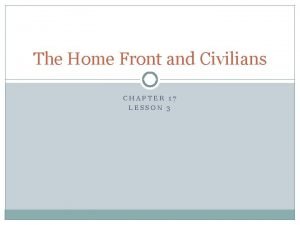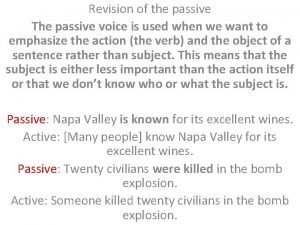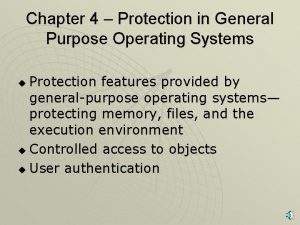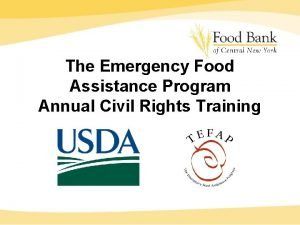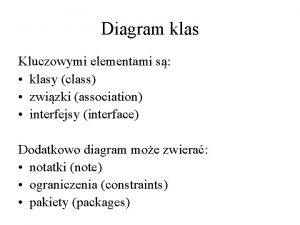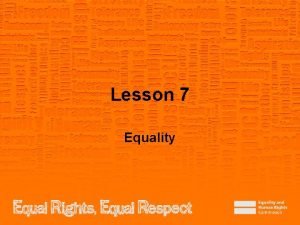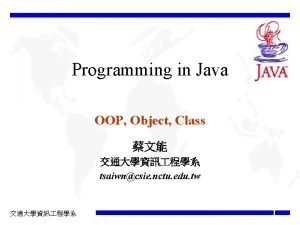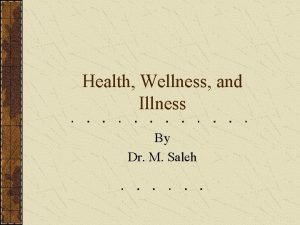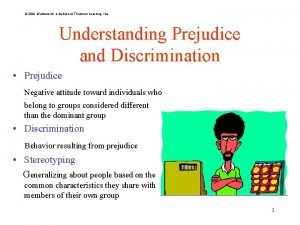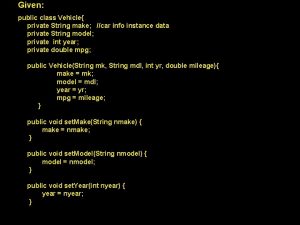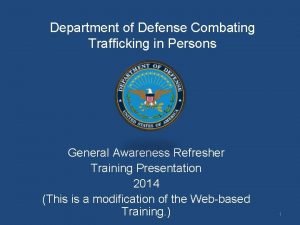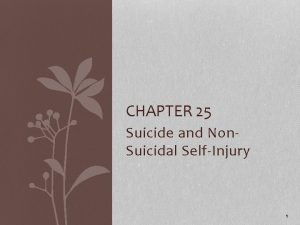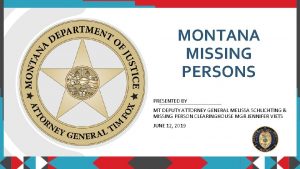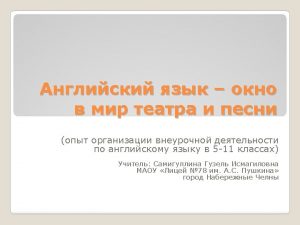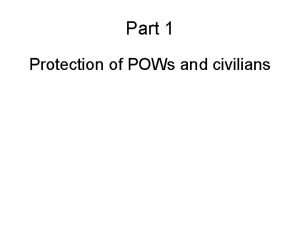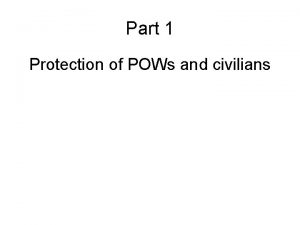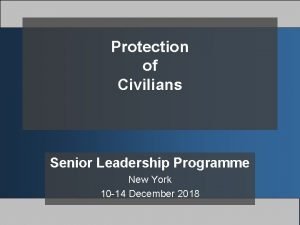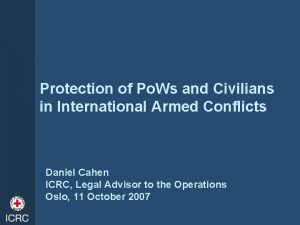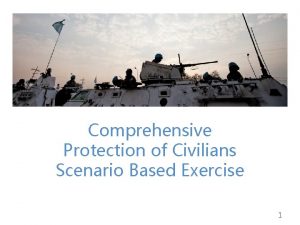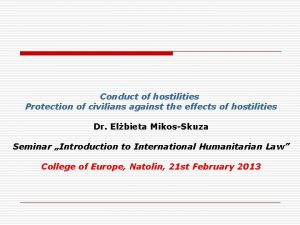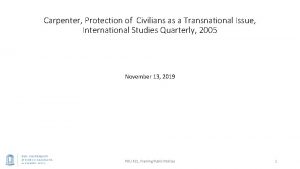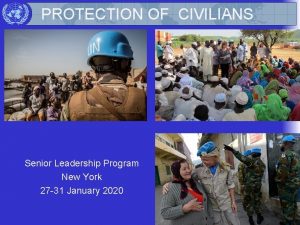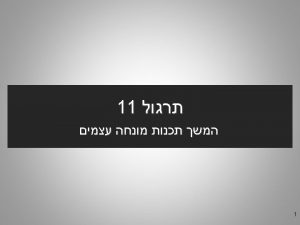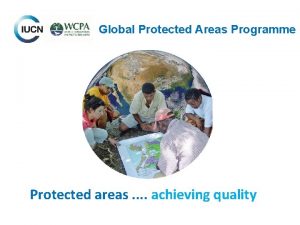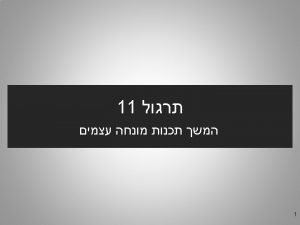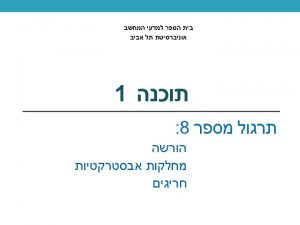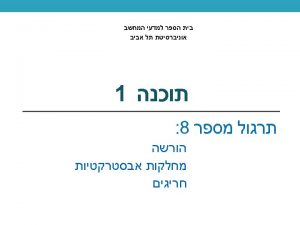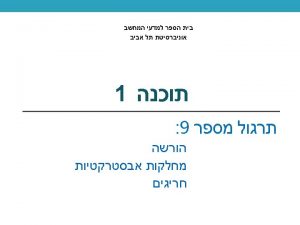Protected Persons Protection of Civilians in the hands
























![RAPE o breach of GC IV [Art. 27 para. 2], PA I [Art. 76] RAPE o breach of GC IV [Art. 27 para. 2], PA I [Art. 76]](https://slidetodoc.com/presentation_image_h/2569090621d7a5e4cef611d5716bad95/image-25.jpg)










![ICJ Advisory Opinion of 2004 on Wall § 103 : „Court […] considers that ICJ Advisory Opinion of 2004 on Wall § 103 : „Court […] considers that](https://slidetodoc.com/presentation_image_h/2569090621d7a5e4cef611d5716bad95/image-36.jpg)
- Slides: 36

Protected Persons Protection of Civilians in the hands of the Enemy Power Dr. Elżbieta Mikos-Skuza Seminar „Introduction to International Humanitarian Law” College of Europe, Natolin, 21 st February 2013

CIVILIAN VICTIMS (persons killed / missing during armed conflicts) First World War Second World War Korean War Vietnam War - a. f. 10 000 - c. p. 50 000 - a. f. 26 000 - c. p. 24 000 - a. f. 100 000 - c. p. 500 000 - a. f. 150 000 - c. p. 3 000

DANGERS FOR THE CIVILIAN POPULATION o Dangers caused by military operations – principle of distinction o Threats to which vulnerable persons are exposed when in the power of the enemy – principle of humanity

SOURCES OF LAW civilians in the power of the enemy 1. Brussels Declaration 1874 2. Hague Regulations 1907 (Art. 42 – 56) 3. Tokyo Draft 1934 of the International Convention on the Condition and Protection of Civilians of Enemy Nationality Who are on Territory Belonging to or Occupied by a Belligerent 4. Geneva Convention Relative to the Protection of Civilian Persons in Time of War 1949 5. Protocol Additional I 1977 (mainly Art. 68 - 79) 6. Protocol Additional II 1977 (mainly Art. 4 - 6) 7. CUSTOMARY LAW

CONCEPT OF CIVILIAN o Not defined in IHL in a positive way; o Until 1977 no definition at all; terminology of HR & GC – „civilians” ≠ „soldiers”; „civilian persons” ≠ „armed forces”; „civilian” ≠ „military”; o Definition of a „civilian” not very important for the protection of persons in the power of the enemy; rather the precise personal scope of application of the provisions conferring the relevant status and rights (the conditions to be met in order to be protected); o Definition of a „civilian” extremely important for the protection against the effects of hostilities

CIVILIANS IN THE POWER OF THE ENEMY ALL CIVILIANS PERSONS PROTECTED

ALL CIVILIANS o Part II of GC IV (Art. 13 – 26) – protection against certain consequences of war (hospital , safety, neutralized zones, protection of wounded and sick, medical personnel, vehicles and hospitals and of particularly vulnerable, e. g. families with particular focus on children) o Section II of Part IV of PA I (Art. 72 – 79) n particular importance of Art. 75 n Art. 76 – 78 – protection of women and children

PERSONS PROTECTED Art. 4 para. 1 of GC IV o victims are in the hands. . . o of a Party to the conflict or Occupying Power and. . . o victims are not nationals of that Party or Occupying Power

ART. 4 - EXCEPTIONS o Nationals of states not bound by GC IV o Nationals of neutral states and cobelligerent states while the states of which they are nationals have normal diplomatic representation in the state in whose hands they are o Persons protected by GC I, GC III NB: Espionage, sabotage, hostile activities don’t change the status (Art. 5)

ICTY – art. 4 “In the context of Art. 4 substantial relations are more important than formal bonds. Therefore ethnicity, and not formal citizenship, becomes the ground for allegiance”. “In present day inter-ethnic conflicts `nationality` refers rather to `ethnicity` than to the legal citizenship. ”

PERSONS PROTECTED – GENERAL RULES ON PROTECTION (ART. 27 – 34 GC IV) n • • • • Protection of : Corporal and mental integrity Human dignity « Honour » Religious convictions Protection from: Racial, ethnic, religious or any other discrimination Coercion or intimidation Collective punishment Pillage Taking of hostages Use as human shields Attacks in reprisals

PERSONS PROTECTED – SPECIAL RULES ON PROTECTION n ALIENS in the territory of a party to the conflict (Art. 35 – 46) n Persons living in OCCUPIED TERRITORIES (Art. 47 – 78) n Civilian INTERNEES (Art. 79 – 135)

ALIENS IN THE ENEMY TERRITORY o Right to leave o Possible restrictions on the right to leave - assignment to residence - civilian internment o Treatment equal to foreigners in peace time for those who choose and who are allowed to remain

OCCUPATION o o o Art 2 GC IV: “The Convention shall also apply to all cases of partial or total occupation of the territory of a High Contracting Party, even if the said occupation meets with no armed resistance. ” No further definition in GC IV, but 1907 Hague Regulations (Art. 42) offer the following definition: “Territory is considered occupied when it is actually placed under the authority of the hostile army. The occupation extends only to the territory where such authority has been established and can be exercised. ” Factual matter, the term “occupation” denotes the absence of not only sovereign title, but also of any other internationally-recognized territorial title, such as a lease, trusteeship or, in the past, mandate.

Art. 43 of HR 1907 „The authority of the legitimate power having in fact passed into the hands of the occupant, the latter shall take all the measures in his power to restore, and ensure, as far as possible, public order and safety [l’ordre et la vie publics] while respecting, unless absolutely prevented, the laws in force in the country”

ART. 64 OF GC IV 1949 q “The penal laws of the occupied territory shall remain q q in force with the exception that they may be repealed or suspended by the Occupying Power in cases where they constitute”: a threat to the security of the Occupying Power; or an obstacle to the application of IHL; „Tribunals of the occupied territory continue to function in respect of all offences” covered by such laws The occupying state may pass new laws necessary for the administration of the occupied territory; to set up new courts

OBLIGATIONS OF THE OCCUPYING POWER o Provide the ocuppied teritory with food and medical supplies; o Maintain the medical services; o Permit religious communities to function; o Observe all rights of accused persons in penal proceedings; o Prohibition of: • annexation; • deportations; • colonization; • forced labour; • taking of hostages…

PROPERTY ON OCCUPIED TERRITORY o Private property - prohibition of pillage - prohibition of destruction (exception: military necessity) - prohibition of confiscation - limited admissibility of requisitions o Public property - OP only administrator and usufructuary - limited admissibility of confiscation (funds, movable property used for military operations) - prohibition of destruction (exception: military necessity)

Prolonged occupation q The temporary nature of occupation—is to safeguard the sovereignty of the ousted or prospective sovereign o What about Near East, Northern Cyprus, Tibet? o Are the purposes of occupation propicious for the occupied territory? q The U. N. Special Rapporteur on the situation of human rights in the Palestinian territories occupied since 1967 has proposed in his August 2007 report that an authoritative determination be requested from the I. C. J. on “the legal consequences of a prolonged occupation that has acquired some characteristics of apartheid and colonialism and has violated many of the basic obligations imposed on an occupying Power. ”

INTERNMENT Non-punitive preventive security measure Example: Art. 78 GC IV „If the Occupying Power considers it necessary, for imperative reasons of security, to take safety measures concerning protected persons it may, at the most, subject them to assigned residence or internment”

INTERNMENT – COMPARISON BETWEEN CI and POW o Differences: - basis for internment (Arts. 41, 42, 68, 78 GC IV) - procedural guarantees (appeal, obligation to re-examin such decisions - Art. 43 GC IV) - end of internment (Art. 132 GC IV - as soon as the reasons which necessitated his / her internment no longer exist + special agreements) o Similarities - treatment

HUMANITARIAN ASSISTANCE TO PROTECTED PERSONS o No absolute right to humanitarian assistance : • Art. 23 IV GC (for sick and wounded soldiers and children under 15) – some conditions to be met; • Art. 59 IV GC (for civilian population in occupied territories)- some conditions to be met; • Art. 70 PA I (for the whole civilian population suffering from the lack of some supplies) – subject to the agreement of the parties concerned. q Problem of Neutral and Independent Humanitarian Action (NIHA)

WOMEN- PROTECTION o General protection as civilian persons o General protection as women (Art. 27§ 2 GC IV, Art. 76§ 1 PA I) o Special protection of pregnant women, maternity cases, nursing mothers, mothers of young children (e. g. , 14, 16, 17, 21 -23, 38§ 5, 89, 127 GC IV, 8, 70, 76§ 2 PA I) o Special protection of interned women

WOMEN - PROBLEMS Categories o Civilians o Combatants or civilians taking part in hostilities (collecting intelligence, suicide attackers, voluntary human shields) Problems o Sexual violence o Displaced o In detention o Missing family members / widowhood
![RAPE o breach of GC IV Art 27 para 2 PA I Art 76 RAPE o breach of GC IV [Art. 27 para. 2], PA I [Art. 76]](https://slidetodoc.com/presentation_image_h/2569090621d7a5e4cef611d5716bad95/image-25.jpg)
RAPE o breach of GC IV [Art. 27 para. 2], PA I [Art. 76] and PA II [Art. 4 para. 2 e]; o grave breach of GC and of customary law = war crime [ICTY: Furundzija and Celebici cases; Statute ICC: Art. 8 para. 2 b (xxii) {i. a. c. } and e (vi) {ni. a. c. }]; o crime against humanity [Statute ICTR: Art. 3; Statute ICTY: Art. 5; Statute ICC: Art. 7 para. 1 g]; o genocide [ICTR: Akayesu case; ICC: Elements of Crime]; o torture [ICTY: Celebici case; ICTR: Akayesu case]; o violation of Art. 3 common to GC and PA II [Art. 4 ICTR] o S. C. Res. 1820 (2008) of 19 June 2008 – widespread and systematic sexual violence against civilians constitutes a threat to international peace and security

CHILDREN - PROBLEMS o Participation of children in hostilities o Identification, family reunification o Education, cultural environment o Detention, death penalty o Assistance and care (including after sexual violence)

PARTICIPATION OF CHILDREN IN HOSTILITIES o PA I 1977 – Art. 77 o Rights of the Child Conv. 1989 – Art. 38 o Optional Protocol CRC 2000 – Art. 1 – 4 o African Charter on the Rights and Welfare of the Child – Art. II and XXII o Statute of the ICC – Art. 8 § 2 b (xxvi)

CHILDREN - PROTECTION o General protection as civilian persons o General protection as children (Art. 77 § 1 PA I) o Special protection (Art. 14, 17, 23 – 26, 38 § 5, 49, 50, 51 § 2, 68 § 4, 76 § 5, 82, 85 § 2, 89, 94, 119 § 2, 132 GC IV, Art. 70 § 1, 74 - 78 PA I)

Protection of journalists o Unless war correspondents, journalists are civilians o No absolute « right to information » o No right to enter a country without authorisation o Attempt to give an enhanced protection to journalist in AP I (Art. 79)

Refugees and Internally Displaced Persons o o o Approximately 10 millions refugees in the world today: huge humanitarian problem of the asylum seekers. Refugees have a specific protection (1951 Convention and 1967 Protocol relating to the Statute of Refugee) but are only marginally covered by IHL (see art. 44 of GC IV and 73 of AP I): individual and status related approach in IRL vs. group / situation based approach in IHL About 20 millions internally displaced persons (IDP), most of them in situations of armed conflicts and therefore covered by IHL – protection against arbitrary displacement – art. 49 GC IV, art. 17 PA II Guiding principles for IDP presented in 1998 to the Human Rights Commission which took note of them ( « soft law » ) - 30 Principles identifying the rights and guarantees relevant to the protection of the IDP in all phases - protection against arbitrary displacement - protection and assistance during displacement - guarantees for safe return, resettlement and reintegration

MISSING o § § § Sources: GC IV, Arts. 25 and 26 AP I, Art. 32 - 34 2006 Convention for the Protection of All Persons from Enforced Disappearance o Preventive measures n n o Measures of identification 2006 Convention: - Interdiction of summary excutions - Interdiction of secret detention Right of families to know the fate of their relatives - Search for persons reported missing - Remains of deceased - Respect and maintenance of gravesites

IHL / HRL Differences: o temporal scope of application – during armed conflicts, dependent on the qualification of the situation / mainly in time of peace o nature – mainly interstate law protecting individuals against enemy state / mainly national law within the frames of international standards protecting individuals against own state

IHL / HRL Differences: o historical development and sources – mainly custom and universal treaties / custom less significant, many regional and soft law instruments o material scope of application - only most fundamental rights / all HR protected o derogations – not allowed / allowed

IHL / HRL Differences: o personal scope of application – mainly individuals meeting certain conditions/ everyone o monitoring institutions – mainly ICRC / many different governmental and nongovernmental bodies

IHL / HRL Similarities: o main goal – to protect human beings o nature in NIAC – to protect against “own” enemy o personal scope of application – the most basic guarantees in a. c. apply to all persons o monitoring institutions – HR bodies become interested in protection of HR in every situations, including a. c. o necessity to interpret IHL / HR according to HR / IHL standards – e. g. judicial guarantees / arbitrary deprivation of life in a. c.
![ICJ Advisory Opinion of 2004 on Wall 103 Court considers that ICJ Advisory Opinion of 2004 on Wall § 103 : „Court […] considers that](https://slidetodoc.com/presentation_image_h/2569090621d7a5e4cef611d5716bad95/image-36.jpg)
ICJ Advisory Opinion of 2004 on Wall § 103 : „Court […] considers that the protection offered by human rights conventions does not cease in case of armed conflict, save through the effects of provisions for derogation of the kind to be found in Art. 4 of the ICCPR. It notes that there are thus three possible situations: o some rights may be exclusively matters of IHL; o others may be exclusively matters of HRL; o yet others may be matters of both these branches of international law. […] The Court will have to take into consideration […] HRL and, as lex specialis, IHL.
 Hands up, hands down
Hands up, hands down A person's trash is another person's treasure
A person's trash is another person's treasure Process of assembling troops and supplies for war
Process of assembling troops and supplies for war It seems that someone cleaned the office on tuesday
It seems that someone cleaned the office on tuesday Protected objects and methods of protection
Protected objects and methods of protection Protected extensible authentication protocol
Protected extensible authentication protocol Federally protected classes
Federally protected classes What protected rome from invasion
What protected rome from invasion Protected weight bearing
Protected weight bearing Eeoc discrimination
Eeoc discrimination Protected mode memory addressing
Protected mode memory addressing Treasury inflation protected securities cfa
Treasury inflation protected securities cfa Federally protected classes
Federally protected classes Federally protected classes
Federally protected classes The kidneys are protected by the ribs and a cushion of fat
The kidneys are protected by the ribs and a cushion of fat Which landforms protected the cities from invasion
Which landforms protected the cities from invasion Dmca protected co to znaczy
Dmca protected co to znaczy Scope of protected cultivation
Scope of protected cultivation Is hair colour a protected characteristic
Is hair colour a protected characteristic Ada protected object
Ada protected object Uml final variable
Uml final variable Protected void
Protected void West coast national park marine protected area
West coast national park marine protected area Dunn's high level wellness grid
Dunn's high level wellness grid Drive geometry
Drive geometry Federally protected classes
Federally protected classes Difference between real protected and virtual mode of 80386
Difference between real protected and virtual mode of 80386 Public class vehicle private string name protected vehicle
Public class vehicle private string name protected vehicle Walmart pto chart
Walmart pto chart Nouns ideas persons places things
Nouns ideas persons places things What is trafficking in persons
What is trafficking in persons Persons in lpscs careers must effectively communicate with
Persons in lpscs careers must effectively communicate with The sad persons scale
The sad persons scale Montana missing person list
Montana missing person list Pronoun examples
Pronoun examples Sad persons scale nursing interventions
Sad persons scale nursing interventions Words that name people, places, things, or ideas
Words that name people, places, things, or ideas


